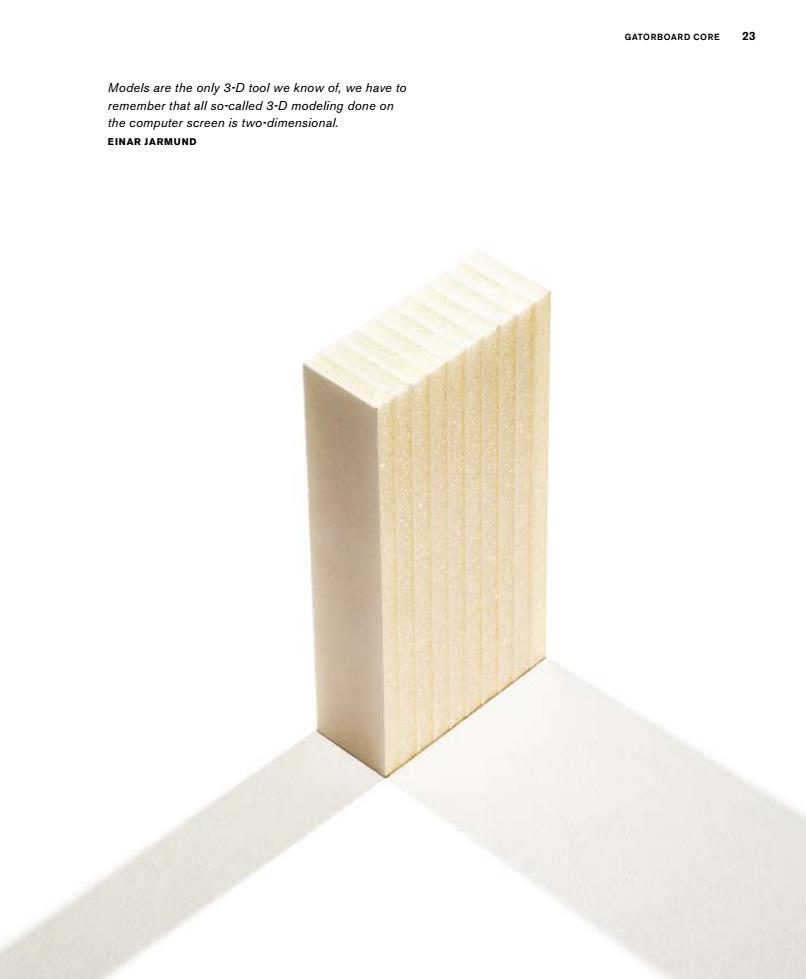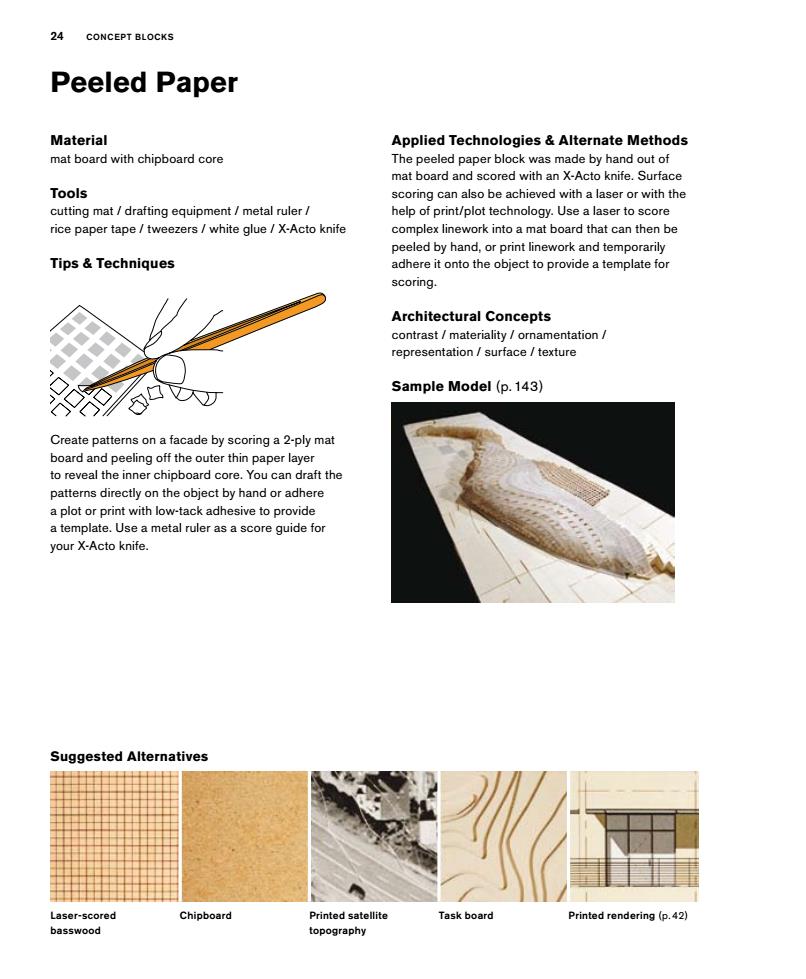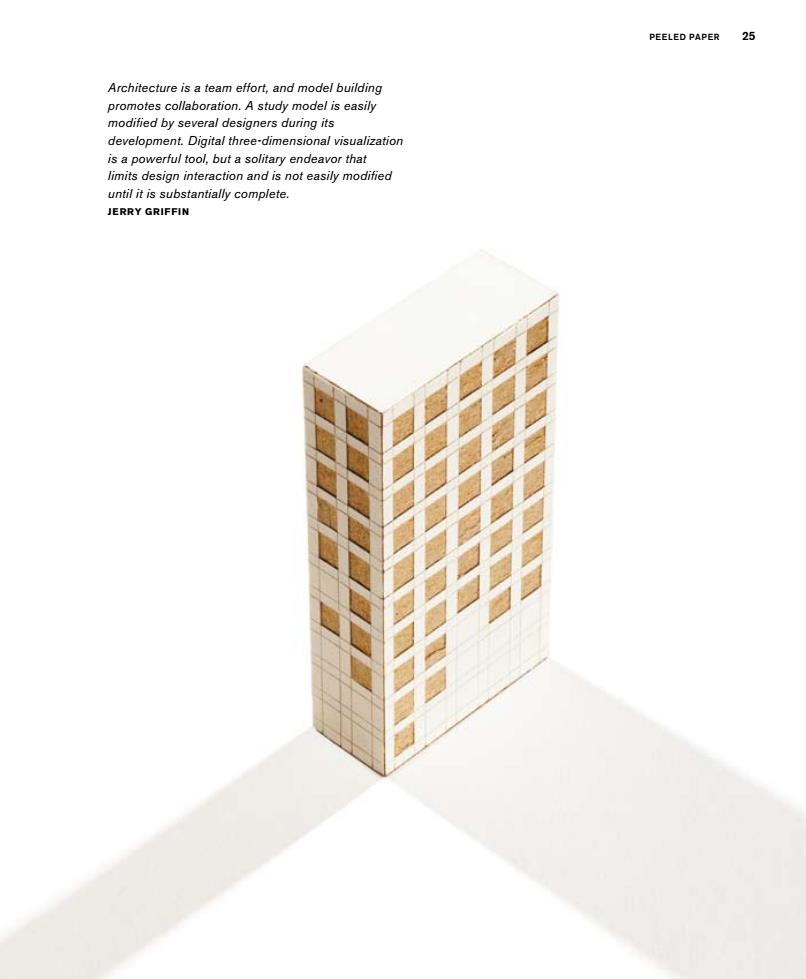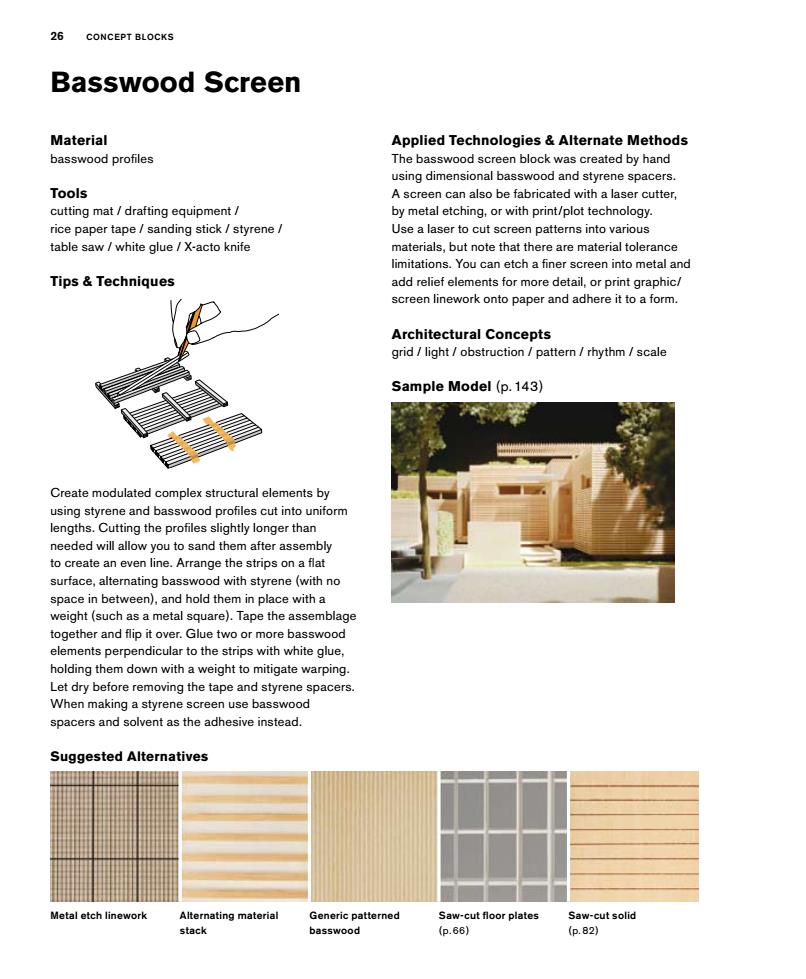
GATORBOARD CORE 23 Models are the only 3-D tool we know of,we have to remember that all so-called 3-D modeling done on the computer screen is two-dimensional. EINAR JARMUND
gatorboard core 23 Models are the only 3-D tool we know of, we have to remember that all so-called 3-D modeling done on the computer screen is two-dimensional. Einar Jarmund

24 CONCEPT BLOCKS Peeled Paper Material Applied Technologies Alternate Methods mat board with chipboard core The peeled paper block was made by hand out of mat board and scored with an X-Acto knife.Surface Tools scoring can also be achieved with a laser or with the cutting mat drafting equipment metal ruler/ help of print/plot technology.Use a laser to score rice paper tape tweezers/white glue /X-Acto knife complex linework into a mat board that can then be peeled by hand,or print linework and temporarily Tips Techniques adhere it onto the object to provide a template for scoring Architectural Concepts contrast /materiality /ornamentation representation surface /texture Sample Model(p.143) Create patterns on a facade by scoring a 2-ply mat board and peeling off the outer thin paper layer to reveal the inner chipboard core.You can draft the patterns directly on the object by hand or adhere a plot or print with low-tack adhesive to provide a template.Use a metal ruler as a score guide for your X-Acto knife. Suggested Alternatives Laser-scored Chipboard Printed satellite Task board Printed rendering(p.42) basswood topography
Applied Technologies & Alternate Methods The peeled paper block was made by hand out of mat board and scored with an X-Acto knife. Surface scoring can also be achieved with a laser or with the help of print/plot technology. Use a laser to score complex linework into a mat board that can then be peeled by hand, or print linework and temporarily adhere it onto the object to provide a template for scoring. Architectural Concepts contrast / materiality / ornamentation / representation / surface / texture Sample Model (p.143) Peeled Paper Material mat board with chipboard core Tools cutting mat / drafting equipment / metal ruler / rice paper tape / tweezers / white glue / X-Acto knife Tips & Techniques Create patterns on a facade by scoring a 2-ply mat board and peeling off the outer thin paper layer to reveal the inner chipboard core. You can draft the patterns directly on the object by hand or adhere a plot or print with low-tack adhesive to provide a template. Use a metal ruler as a score guide for your X-Acto knife. 24 Concept Blocks Suggested Alternatives Laser-scored basswood Chipboard Printed satellite topography Task board Printed rendering (p.42)

PEELED PAPER 25 Architecture is a team effort,and model building promotes collaboration.A study model is easily modified by several designers during its development.Digital three-dimensional visualization is a powerful tool,but a solitary endeavor that limits design interaction and is not easily modified until it is substantially complete. JERRY GRIFFIN
peeled paper 25 Architecture is a team effort, and model building promotes collaboration. A study model is easily modified by several designers during its development. Digital three-dimensional visualization is a powerful tool, but a solitary endeavor that limits design interaction and is not easily modified until it is substantially complete. Jerry Griffin

26 CONCEPT BLOCKS Basswood Screen Material Applied Technologies Alternate Methods basswood profiles The basswood screen block was created by hand using dimensional basswood and styrene spacers. Tools A screen can also be fabricated with a laser cutter, cutting mat drafting equipment/ by metal etching,or with print/plot technology. rice paper tape/sanding stick styrene/ Use a laser to cut screen patterns into various table saw white glue /X-acto knife materials,but note that there are material tolerance limitations.You can etch a finer screen into metal and Tips Techniques add relief elements for more detail,or print graphic/ screen linework onto paper and adhere it to a form. Architectural Concepts grid /light /obstruction pattern /rhythm/scale Sample Model(p.143) Create modulated complex structural elements by using styrene and basswood profiles cut into uniform lengths.Cutting the profiles slightly longer than needed will allow you to sand them after assembly to create an even line.Arrange the strips on a flat surface,alternating basswood with styrene (with no space in between),and hold them in place with a weight(such as a metal square).Tape the assemblage together and flip it over.Glue two or more basswood elements perpendicular to the strips with white glue, holding them down with a weight to mitigate warping. Let dry before removing the tape and styrene spacers. When making a styrene screen use basswood spacers and solvent as the adhesive instead. Suggested Alternatives Metal etch linework Alternating material Generic patterned Saw-cut floor plates Saw-cut solid stack basswood (p.66) (p.82)
Applied Technologies & Alternate Methods The basswood screen block was created by hand using dimensional basswood and styrene spacers. A screen can also be fabricated with a laser cutter, by metal etching, or with print/plot technology. Use a laser to cut screen patterns into various materials, but note that there are material tolerance limitations. You can etch a finer screen into metal and add relief elements for more detail, or print graphic/ screen linework onto paper and adhere it to a form. Architectural Concepts grid / light / obstruction / pattern / rhythm / scale Sample Model (p.143) Basswood Screen Material basswood profiles Tools cutting mat / drafting equipment / rice paper tape / sanding stick / styrene / table saw / white glue / X-acto knife Tips & Techniques Create modulated complex structural elements by using styrene and basswood profiles cut into uniform lengths. Cutting the profiles slightly longer than needed will allow you to sand them after assembly to create an even line. Arrange the strips on a flat surface, alternating basswood with styrene (with no space in between), and hold them in place with a weight (such as a metal square). Tape the assemblage together and flip it over. Glue two or more basswood elements perpendicular to the strips with white glue, holding them down with a weight to mitigate warping. Let dry before removing the tape and styrene spacers. When making a styrene screen use basswood spacers and solvent as the adhesive instead. 26 Concept Blocks Suggested Alternatives Metal etch linework Alternating material stack Generic patterned basswood Saw-cut floor plates (p.66) Saw-cut solid (p.82)

BASSWOOD SCREEN 27 Simplicity is complexity resolved. CONSTANTIN BRANCUSI
basswood screen 27 Simplicity is complexity resolved. Constantin Brancusi